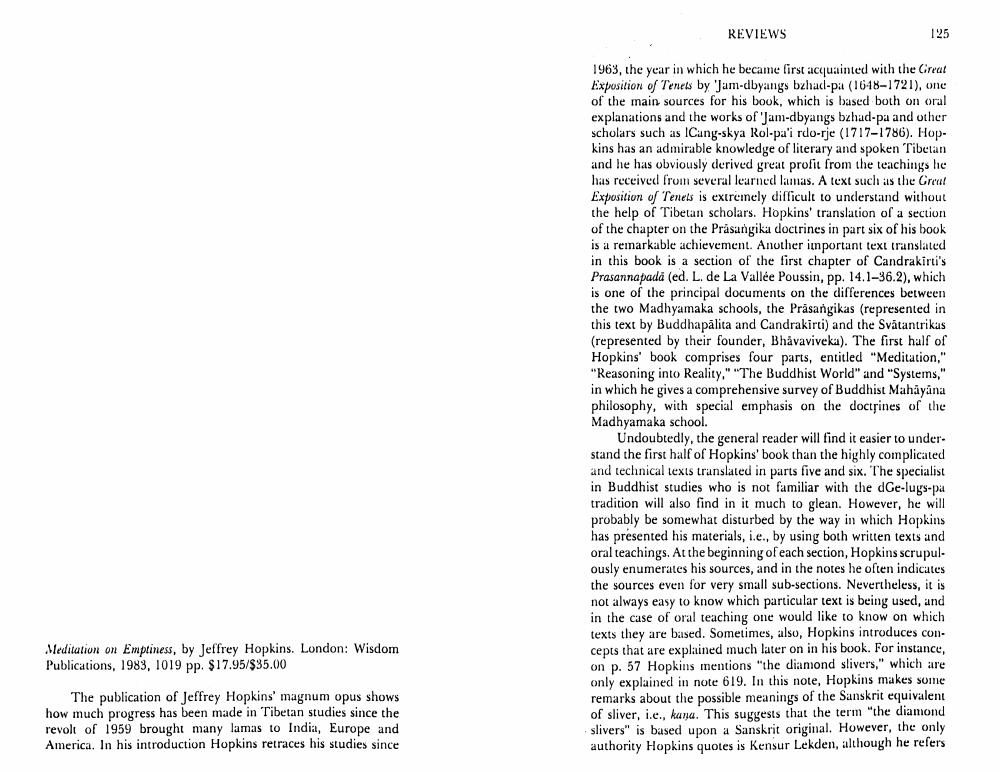Book Title: Book Reviews Author(s): J W De Jong Publisher: J W De Jong View full book textPage 1
________________ REVIEWS 125 1963, the year in which he became first acquainted with the Great Exposition of Tenets by 'Jam-dbyangs bzhac-pa (16-18-1721), one of the main sources for his book, which is based both on oral explanations and the works of 'Jam-dbyangs bzhad-pa and other scholars such as Cang-skya Rol-pa'i rdo-rje (1717-1786). Hopkins has an admirable knowledge of literary and spoken Tibetan and he has obviously derived great profit from the teachings he has received from several learned lamas. A text such as the Great Exposition of Tenels is extremely difficult to understand without the help of Tibetan scholars. Hopkins' translation of a section of the chapter on the Prasangika doctrines in part six of his book is a remarkable achievement. Another important text translated in this book is a section of the first chapter of Candrakirti's Prasannapada (ed. L. de La Vallée Poussin, pp. 14.1-36.2), which is one of the principal documents on the differences between the two Madhyamaka schools, the Prasangikas (represented in this text by Buddhapalita and Candrakiri) and the Svatantrikus (represented by their founder, Bhavaviveka). The first half of Hopkins' book comprises four parts, entitled "Meditation." "Reasoning into Reality." "The Buddhist World" and "Systems," in which he gives a comprehensive survey of Buddhist Mahayana philosophy, with special emphasis on the doctrines of the Madhyamaka school. Undoubtedly, the general reader will find it easier to understand the first half of Hopkins' book than the highly complicated and technical texts translated in parts five and six. The specialist in Buddhist studies who is not familiar with the dGe-lugs-pa tradition will also find in it much to glean. However, he will probably be somewhat disturbed by the way in which Hopkins has presented his materials, i.e., by using both written texts and oral teachings. At the beginning of each section, Hopkins scrupul. ously enumerates his sources, and in the notes he often indicates the sources even for very small sub-sections. Nevertheless, it is not always easy to know which particular text is being used, and in the case of oral teaching one would like to know on which texts they are based. Sometimes, also, Hopkins introduces concepts that are explained much later on in his book. For instance, on p. 57 Hopkins mentions "the diamond slivers," which are only explained in note 619. In this note, Hopkins makes some remarks about the possible meanings of the Sanskrit equivalent of sliver, i.e., kana. This suggests that the term "the diamond slivers" is based upon a Sanskrit original. However, the only authority Hopkins quotes is Kensur Lekden, although he refers Meditation on Emptiness, by Jeffrey Hopkins. London: Wisdom Publications, 1983, 1019 pp. $17.95/$35.00 The publication of Jeffrey Hopkins' magnum opus shows how much progress has been made in Tibetan studies since the revolt of 1959 brought many lamas to India, Europe and America. In his introduction Hopkins retraces his studies sincePage Navigation
1 2 3 4 5 6 7
